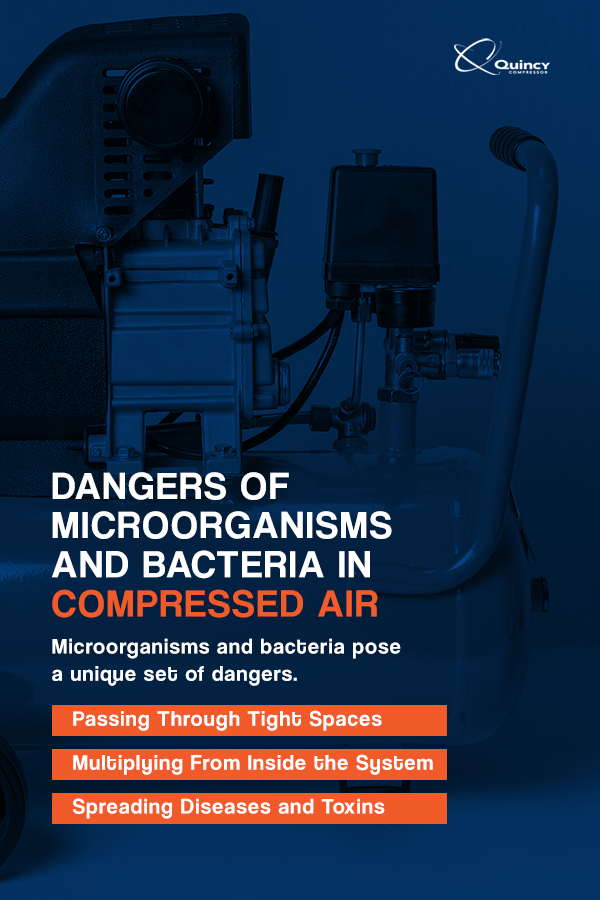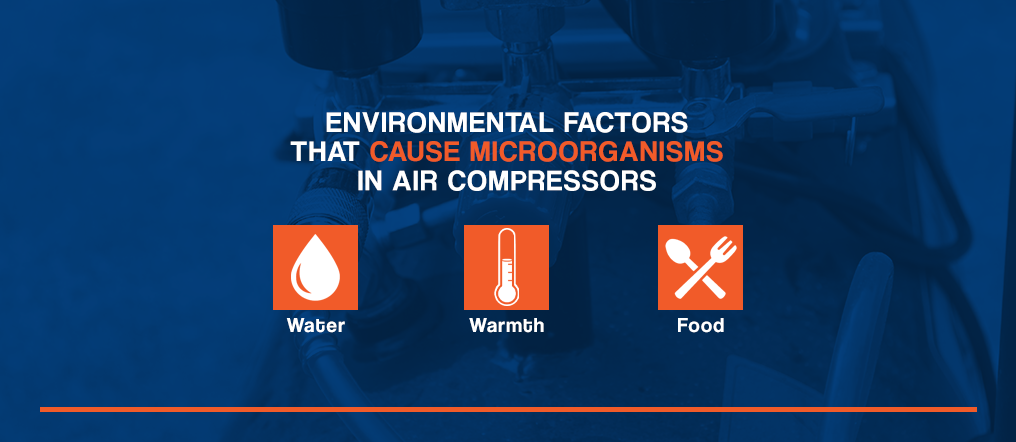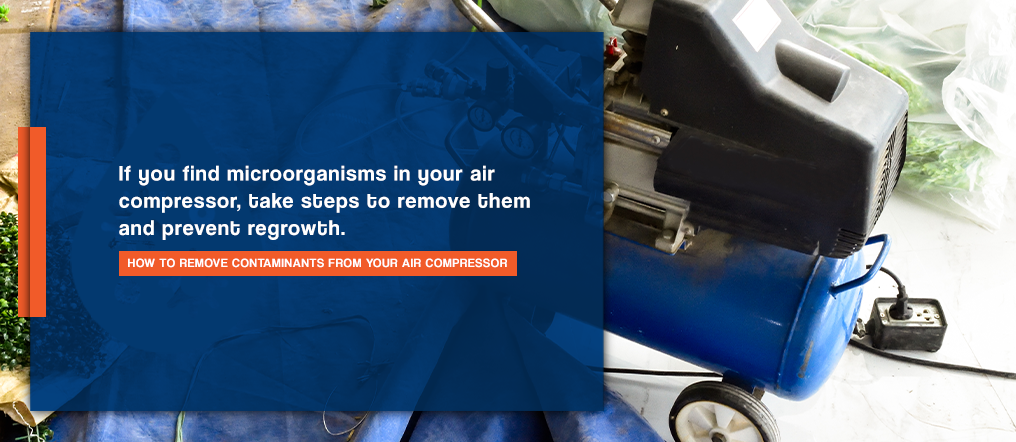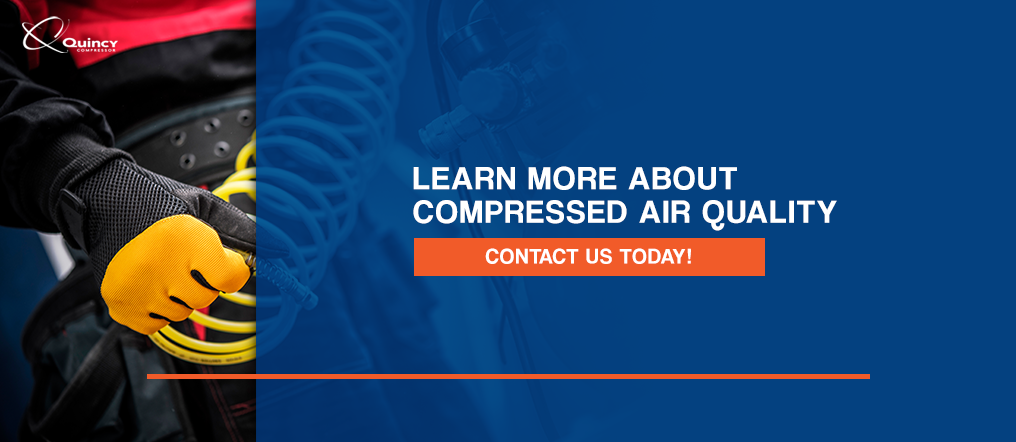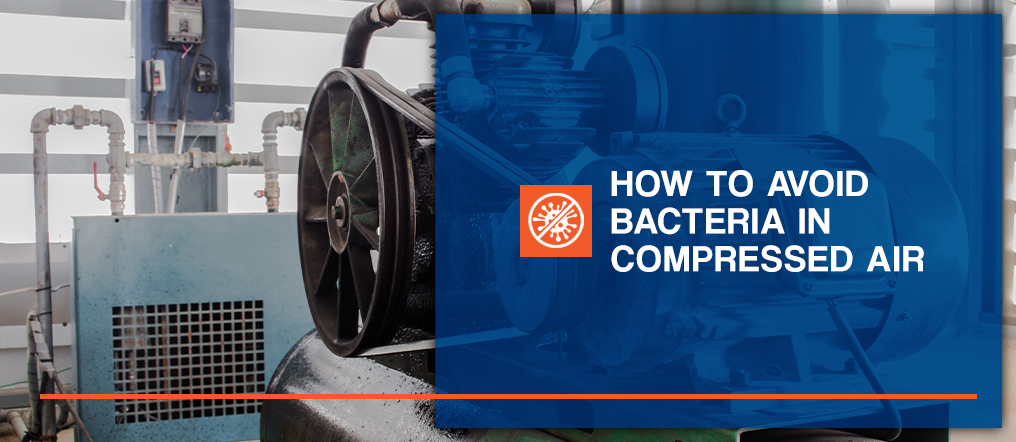
Compressed air has many applications in industrial plants around the world. Air compressors, however, can harbor dangerous microorganisms if not properly maintained. Clean air in the workplace is always important for human safety, especially in food, medical and pharmaceutical industries. Microbial contamination of compressed air can compromise air quality and lead to serious hazards. Whether consumed or breathed in, certain microorganisms can cause temporary or chronic symptoms and even death.
If you have an air compressor in your facility, you should understand how to avoid microorganisms and bacteria. Make sure your environment is not one in which microorganisms will be able to thrive — limit humidity and keep ambient air cool. Plan regular cleaning and test your compressed air quality often by using testing kits. Replace filters, pipes and other elements of your compressed air system regularly. Learn to limit, identify and remove contaminants from your air compressor system with the information below.
Dangers of Microorganisms and Bacteria in Compressed Air
Microorganisms and bacteria pose a unique set of dangers. Bacteria, viruses and bacteriophages are all examples of microorganisms that can contaminate air compressors. Bacteria are the main concern, as viruses need a host to multiply. Viruses are unlikely to survive long in an air compressor system, but bacteria will under the right conditions.
Ingesting certain microorganisms through food, medicine or air can cause serious problems. Foodborne bacteria like E. coli can disrupt the digestive system and cause death in extreme cases. Airborne toxins can result in allergy-like symptoms and long-term respiratory issues.
Passing Through Tight Spaces
Microorganisms are extremely small — small enough to pass through many filters. Bacteria can be 1 to 3 micrometers, small enough to permeate basic filtration systems with ease. For comparison, a bacterium is smaller than many “tiny” things, including a single grain of beach sand, a grain of salt and a red blood cell. A bacterium is only visible through an optical microscope or, in the case of the smallest bacteria, a scanning electron microscope.
Because of their size, they can be tricky to catch. They can live in tight, difficult-to-reach spaces, hidden from view. That’s why taking preemptive measures to limit their spread is so important.
Multiplying From Inside the System
Because they’re living creatures, microorganisms will continually multiply under the right conditions. Though they’re individually microscopic, they will build up over time and become increasingly dangerous. They tend to thrive in high humidity and warmth — a damp, warm environment will allow microorganisms to reproduce rapidly.
Certain contaminants, especially oil, will act as food for microorganisms and promote their multiplication. Cleaning oil, water and other substances from your air compressor will make bacterial survival less likely.
Spreading Diseases and Toxins
If certain bacterias come into contact with food or medicine, they can cause disease or death. This is especially true of salmonella, shigella, E. coli and coliforms. When ingested, microorganisms like these can cause a slew of unpleasant symptoms, including severe stomach cramps, vomiting, diarrhea and fever. These symptoms can last for several days and lead to death. E. coli causes about 100 deaths per year in the United States. For the sake of human health and well-being, it’s vital to eliminate these microorganisms.
Additionally, mold and bacteria result in air contamination — they can produce toxins and cause damage to anyone breathing the air. Some people are more sensitive to breathing mold than others, especially those with asthma, lung disease or immune suppression. Breathing mold can lead to allergy-like symptoms. Fungal infections can cause coughing, wheezing and upper respiratory issues in otherwise healthy people.
Even if there’s no chance of contaminated compressed air entering food or pharmaceutical products, it’s still important to limit the spread of these microorganisms. They can degrade air quality and cause both short- and long-term symptoms in those breathing the air.
Environmental Factors That Cause Microorganisms in Air Compressors
As living creatures, microorganisms can only survive in certain environments. They thrive in warm, humid conditions, especially with other substances to feed on, like oil. All bacteria and fungi need some amount of water to survive, but the required humidity level depends on the species. Microorganisms will reproduce and thrive with:
- Water: Though different species of microorganisms require different moisture levels, all need some amount of water to survive. Your air compressor’s intake air should be dry, and you should use tools like liquid drains and aftercoolers.
- Warmth: For the same reason you put leftover food in a refrigerator, you should keep your air compressor in a cool environment. Bacteria require warm temperatures to grow.
- Food: When we think of bacteria, we may not think of them as living organisms that need to eat, but they are! Bacteria require nutrients like all other living things. Different species of microorganisms need different nutrients. Some photosynthesize, some eat organic compounds like sugar and fat and others eat inorganic compounds like carbon dioxide. Limit potential microorganism food sources in your facility.
To limit the growth of microorganisms in your compressed air system, create an environment hostile to their survival. Make sure your air compressor and its parts are in a dry, cool area, and take preventative measures regularly.
Once you’ve placed your air compressor in an appropriate environment, make sure to address any leaks in the system. Keep in mind that leaks can allow outside substances to enter, which contaminate the system. When there are leaks, the system becomes susceptible to water droplets, oils and microorganisms, which will collect and build up over time.
You should check for leaks in your compressed air system often. Addressing leaks will help limit contamination, and it will also improve the system’s efficiency, saving you time and money. When leaks are present, air compressors will eat up more power than necessary as they function.
Preventing Microorganism Growth With Environmental Factors
Because microorganisms are so small, they can be difficult to find and address. Preventing them from building up in the first place is the most important thing you can do. Create an environment optimized for reducing microbial growth. To prevent microorganism growth, you should:
- Fix leaks in your air compressor system: You can check for leaks by listening for a hissing sound or using an ultrasonic frequency reader. You can also apply soapy water to places where you suspect a leak — if there is one, bubbles will form.
- Install several filters: Implement several filters within your system, including particulate and absorber models. It’s especially important to have filters where air enters the system, but you should also have filters in line with piping.
- Clean and replace filters regularly: You should do this on a regular schedule, especially if the filters become damp. Clean your filters by blowing away dust, dirt and debris. Replace old or damaged filters routinely.
- Make sure ambient air is cool and dry: If the air entering your air compressor is humid or warm, microorganisms will thrive. Place your air compressor in an appropriate environment.
- Test your compressed air often: Perform routine air quality tests to check for contaminants. You’ll find more details about performing these tests in the following section.
How to Identify Bacteria in Air Compressors
To check for the presence of bacteria, you should perform air quality tests at regular intervals. Within your compressed air system, certain areas are most likely to harbor microorganisms. These areas are most susceptible to condensate buildup and collection of outside particles. You should plan to sample and test these areas at scheduled intervals. The most common places to find microorganisms include:
- Dead-end runs.
- Drains.
- Compressed air coils.
- Filters.
- Leaks.
Deciding When and Where to Sample Your Compressed Air System
To test for microorganisms like bacteria, mold and yeast, take samples close to high-risk points. When deciding where to take samples from, you can use a percentage-based system. For instance, if you have 24 points to sample, choose eight different ones to test each year — after three years, you’ll have sampled all of them. It’s wise to choose sample locations along the compressed air system to see if the air quality degrades as it moves through. That way, you can identify problem areas.
Regarding frequency, you might choose to perform tests annually, semi-annually or quarterly. Check the standard requirements for your industry — food processing, medical and pharmaceutical facilities usually have to test for microbial life more often than other types of facilities. In addition to your scheduled tests, you should perform tests before and after making changes to the system. Test the system after replacing or cleaning any elements, including filters, valves or piping.
When you perform these tests, you should look for any potential contaminants. These include dirt, rust, water vapor, condensed liquid, oil vapor and liquid oil. Use a sample test kit to check for microbial contamination.
How to Sample Using a Compressed Air Microbial Test Unit
When using a Compressed Air Microbial Test Unit (CAMTU), the process for taking and testing samples is as follows:
- Wear gloves and a mask to ensure your safety and limit exposure to microbial organisms.
- Connect the inlet tubing to the sample port.
- Open the compressed air valve to the sample port.
- Open the shut-off flap.
- Purge the sample port.
- Close the shut-off valve.
- Attach the inlet tubing to the test unit.
- Place the petri dish inside the test unit.
- Close the test unit.
- Open the shut-off valve and let it run for 20 seconds.
- Cover, remove and incubate the petri dish.
After completing these steps, microbial organisms will become visible over time.
Compressed air standard air quality varies across industries. Health and food-related sectors must comply with higher standards. Generally, you want to have less than one colony-forming unit per petri dish. A colony-forming unit is an estimation of the number of bacteria or fungal cells that could multiply. This will exclude dead microorganism cells, as they cannot reproduce.
How to Remove Contaminants From Your Air Compressor
If you find microorganisms in your air compressor, take steps to remove them and prevent regrowth. Modern air compressor technology is designed to minimize contaminants. Several tools will help reduce the likelihood of microorganism buildup and remove microorganisms from your air compressor system. Learn about what these parts do and what your role in maintaining their effectiveness is. Follow the below steps to remove contaminants.
Use Filters and Replace Them Often
Have several filters in place along the compressed air system, and keep them fresh. A visual inspection of your filters might not indicate you need to replace them. After all, microorganisms are not visible to the naked eye. In addition to looking at your filters, monitor differential pressure — a significant drop can alert you of an issue. Check these gauges often, and replace filters when issues are present.
You should also plan to replace filters at predetermined time intervals, whether or not they seem to be working. Replace filters at least annually, or more often depending on how heavily you use them.
Use an Aftercooler to Reduce Water Content
Compressed air generates heat. And since warm temperatures contribute to microbial reproduction, it’s important to lower the temperatures in your system. You can accomplish this with an aftercooler, placed directly after the compressor. It traps the condensation that would flow through the system.
Use a Mist Eliminator Filter
Using a mist eliminator with a high-volume tank and a built-in differential pressure gauge will make a big difference in removing microbial contamination. A filter like this removes oil, water and other particles from compressed air. While it might not eliminate the tiniest microbial life, it’ll limit the water and oil necessary for microorganisms to live and reproduce.
Use a Zero-Loss Liquid Drain With Electronic Controls
Compressed air system lines will accumulate condensation. Since microorganisms need water to survive, it’s important to drain the system of built-up condensation. Some air compressors have a manual valve for releasing condensation, but this can allow compressed air to escape and go to waste. Internal float drains, which open when water builds up, can become jammed open, which releases air, or jammed shut, which fails to release the water.
The best option is a zero-loss, electrically controlled drain. These drains will sense condensation levels and open the valve when needed. The valve closes before any compressed air is wasted. One of these zero-loss drains may be more expensive than manual or internal float drains, but they’re much more efficient.
Properly Dispose of Condensate
Always dispose of condensate properly — never dump it down the drain. Due to its potential oil and contaminate content, it’s considered hazardous waste. Use a condensate purifying device. This device will separate oil from water so you can dispose of oil as hazardous waste.
Learn More About Compressed Air Quality
If you have an air compressor or plan to purchase one, you need to know how to maintain clean and safe air. To achieve this, you’ll have to account for possible microbial contamination of your air compressor’s parts. Place your air compressor in a cool, dry environment, and install all necessary filters, aftercoolers and drains. Regularly test for microorganisms and set standards for acceptable air quality.
To learn more about promoting clean and safe compressed air, connect with air compressor experts by contacting Quincy Compressor with any questions.


